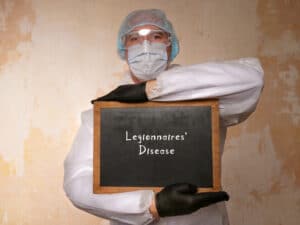Legionnaires Disease from Legionella in Your Hot Water Tank

Legionnaires Disease bacteria – Legionella – can grow in your hot water tank. Legionnaires Disease is a potentially fatal respiratory disease that can be caused by the Legionella bacteria inhaled during a shower.
 So, you can catch Legionnaires Disease from a hot water heater.
So, you can catch Legionnaires Disease from a hot water heater.
Legionnaires Disease is spread from inhaling hot water heater mist or droplets.
Hot water tanks, shower heads, hot water taps and pipework can all potentially breed Legionella bacteria.
Electric water heaters have an increased hazard.
Electric water heaters are more susceptible to Legionella growth because of the ≈25°C lower temperatures at the tank bottom.
The growth of the bacteria in hot water tanks is highest between 25°C to 50°C.
This is why you should never turn your electric or gas water heater below 60°C (140°F).
This is based on the building code and scientific research.
Legionella Bacteria
Legionella bacteria is very common.
Legionella is found in reservoirs, lakes, rivers, creeks and hot springs.
It is also found in artificial bodies of water like hot water systems, spas, and the air conditioning cooling towers of large buildings.
39 different species of Legionella bacteria have been identified.
Legionnaires Disease Outbreak Melbourne
There was a Legionnaires Disease outbreak in Melbourne between 26 July and 20 August 2024.
There were over 100 confirmed cases in the Melbourne metropolitan area.
An air cooling tower cooling tower was blamed for this outbreak.
Legionnaires Disease from Hot Water Tanks is Preventable
The good news is that Legionnaires Disease from hot water heaters is totally preventable.
To prevent the Legionella bacteria from growing, do not lower hot water tank temperature below 60°C (140°F).
You need to be informed to protect your family’s health…
Legionnaires Disease Symptoms
Legionnaires disease is a lung infection or severe form of pneumonia (lung inflammation). Legionnaires disease symptoms may include coughs, shortness of breath, muscle aches in the chest, fever, chills, headaches, diarrhoea, nausea, or vomiting.
Some people may not even develop symptoms.
Legionnaires disease is not spread person to person.
It is spread by legionella in contaminated water mist or droplets that are inhaled.
Two common sources are large air conditioning units and showers.
Treatment is with antibiotics.
Legionnaires Disease Hot Water Heater

Hot water heater tanks, shower heads, hot water taps and pipework can breed Legionnaires Disease bacteria, as it breeds in stationary warm water (25-50°C).
To prevent the Legionnaires Disease bacteria from growing in your hot water tank, do not lower hot water tank temperature below 60°C (140°F).
Legionnaires Disease, or Legionellosis, is a sometimes fatal illness caused by a bacteria that can grow in a hot water heater.
Legionnaires Disease is a respiratory disease that can cause severe pneumonia when hot water heater droplets are inhaled during a shower. It can also come from a contaminated air conditioning system.
Watch this quick 30 second Community Service Announcement:
Legionnaires Disease Hot Water Tank Temperature
Keeping the hot water heater tank temperature set to a minimum of 60°C (140°F) prevents the Legionnaires Disease bacteria – Legionella pneumophila – from growing.
If Legionella infected water is inhaled in small airborne droplets from the water heater, as would happen when taking a shower or whirlpool bath, the individual could end up with Legionnaires Disease.
The Legionella bacteria can multiply exceptionally well in warm water, between 25° to 50°C (77°F to 122°F).
The solution is to keep the hot water INSIDE the tank set to a minimum of 60°C.
This applies to all electric and gas storage tank systems, including solar and heat pump units, which also have storage tanks.
Your plumber would have set your system up to run at 60°C (140°F) when it was installed.
Plumbers know to set the temperature correctly.
Turning your hot water tank down, to save money, can backfire, if you go below 60°C.
The best advice is to leave it as set by your plumber.
Air conditioning system can also be a breeding groud for Legionnaires Disease and require anti-bacterial agents to be added to their water to stop the growth.
What About Scalding?
Tempering or mixing valves are used to reduce the temperature to prevent possible scalding.
These mix cold water with the hot water AFTER it leaves your tank.
Your plumber will typically set the tempering valve to deliver 50°C water at the hot water tap.
Most tankless hot water systems are factory pre-set to 50°C, so they do not require the use of tempering valves.
Added Hazard with Electric Storage Tank Hot Water Heaters
The World Health Organisation — WHO — recommends that water be heated and stored at 60°C.
However, Canadian studies have shown, even when the thermostat is set at 60°C, a high percentage — approximately 40% — of electric water heaters remain contaminated because of the lower temperature, about 30°C to 40°C at the bottom of the tank.
No water heaters using gas were contaminated.
The authors concluded that, because of design variables, use of an electric water heater was the most significant factor leading to Legionella contamination in hot water in the home.
How can this still go wrong?
Some homeowners unknowingly reduce the temperature setting on their hot water system to conserve energy.
A good idea in theory, but a bad idea in view of the Legionella issue.
Some homeowners shut off their hot water tanks when they go on holiday, but an outdoor hot water tank in the sun may provide the perfect conditions for the bacteria to multiply.
Old or malfunctioning hot water heaters may also have actual temperatures below 60°C, potentially causing the problem.
Regular inspections by a licensed plumber can help ensure that the problem is prevented.
Tankless Continuous Flow Systems Solve The Problem
Another solution is the use of continuous flow hot water heaters.
These systems are tankless, so there is no breeding ground for the bacteria.
They heat the fresh incoming water as it passes through the unit.
As they only need to heat the water to 50°C and only run when you need hot water, they save energy and money, too.
Another advantage of continuous flow systems is that they never run out of hot water.
- BBQ – Gas and Charcoal BBQ Features – Charcoal BBQ vs Gas BBQ Comparison - March 31, 2025
- GPL Gas (GPL Fuel) – GLP Gas – LPG Gasul: GLP-GPL Gas Station - March 26, 2025
- Think LPG When Building a New Home - February 26, 2025
Steve Reynolds
Technical Consultant
Steve Reynolds is a leading expert in the LPG industry with over 22 years of experience. As part of the national management team at ELGAS, Steve ensures the safe and efficient storage, handling, and transportation of LPG. He serves as the lead investigator for incidents and collaborates with authorities on industry developments.
Steve is a technical advisor to Standards Australia and Gas Energy Australia (GEA), and an active member of the World LPG Association (WLPGA), contributing to global standards and technical reviews. He holds a BSc. (Hons) in Industrial Chemistry from UNSW and has held senior safety and technical roles at ELGAS, making him a trusted authority in LPG safety and standards.
